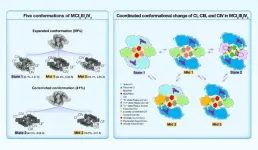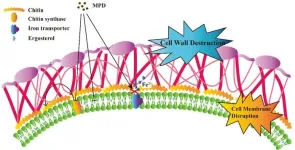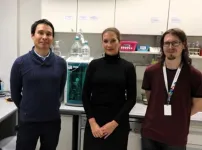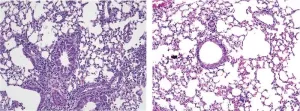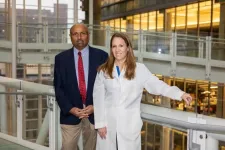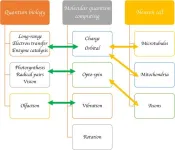(Press-News.org) There are 40% more Hispanic/Latino kids diagnosed with acute lymphoblastic leukemia (ALL) than white non-Hispanic/Latino children; actually, Hispanic/Latino individuals have the highest risk of ALL in the United States. However, the basis for this difference is not well understood. Researchers recently identified a genetic variant that accounts for the increased risk of B-cell ALL in Hispanic/Latino children, and using ancient DNA, they traced the mutation all the way back to the first migrants who entered the Americas ~13,000 years ago.
“We were able to use genetic studies in diverse populations to identify this new risk factor that explains some of the population differences in ALL risk,” says Vijay Sankaran, a lead author of the study and a physician-scientist at the Dana-Farber/Boston Children's Cancer and Blood Disorders Center. The findings were published in Cell Genomics on March 26 and are a close collaboration with colleagues at the University of Southern California.
Sankaran and colleagues employed genome-wide association studies (GWAS) to look for mutations contributing to racial/ethnic differences in B-cell ALL. The team discovered a genetic variant that explains a significant portion of the increased risk in Hispanic/Latino kids. The mutation reduces the expression of a gene called IKZF1, which encodes for the protein Ikaros that is required for B-cell development. The mutation is found at a much lower frequency in white non-Hispanic/Latino children.
Sankaran, an Associate Member at the Broad Institute, and his laboratory, led by postdoctoral fellow Lara Wahlster, provide functional data that suggest the variant slows B-cell maturation and, in turn, increases the chances of a cancerous mutation popping up in the cells.
Hispanic/Latino individuals in the United States are known to have diverse ancestral origins, and the researchers found that this risk variant appeared to arise from Indigenous American ancestral origins. On the other hand, the variant was nearly absent in people with European ancestry. This observation may explain the higher prevalence of ALL in some countries in Latin America, such as Mexico, where there is a greater contribution of Indigenous American ancestry, compared to countries like Argentina, where there is a lower contribution of such ancestry.
The researchers then analyzed ancient DNA samples to understand when the risk variant arose in human history. The oldest previously sequenced ancient DNA from an Indigenous American individual, found at the Anzick site in Montana, carried the mutation. This means the risk variant was present among the first migrants who entered the Americas approximately 13,000 years ago.
Further investigation revealed that the variant was promoted by natural selection. Sankaran and colleagues speculated that carrying the mutation may have protected people against infection since IKZF1 plays a role in immune function.
“Exploring ancient DNA provides insights into the roots of modern-day health differences, bridging the gap between our past and the pressing health challenges facing our society today,” says Sankaran.
The study's findings may provide insights into the higher rates of treatment resistance and relapse observed in Hispanic/Latino children with ALL. Sankaran emphasizes the need for further research to gain a comprehensive understanding of the implications of this variant. Ultimately, Sankaran hopes this knowledge may lead to ways of preventing leukemia from developing in a child carrying the identified genetic variant.
“I hope our work will ultimately pave the path towards preventing this disease,” says Sankaran.
###
This study was funded by the National Institutes of Health (NIH) (R01CA262263, R01CA262263, R01CA262263, R01CA262263, and R01CA265726), the New York Stem Cell Foundation, the Leukemia & Lymphoma Society, and the Dana-Farber Cancer Institute Presidential Priorities Initiative.
END
Ancient DNA reveals origin of racial/ethnic disparity in a childhood cancer
Researchers identify a genetic variant that explains why more Hispanic/Latino children are diagnosed with acute lymphoblastic leukemia (ALL) and uncover the mutation’s Indigenous American ancestral origins.
2024-03-26
ELSE PRESS RELEASES FROM THIS DATE:
USC researchers find genetic variant contributing to disparities in childhood leukemia risk
2024-03-26
Acute lymphoblastic leukemia (ALL), the most common childhood cancer, disproportionately affects children of Hispanic/Latino origin in the United States. They are 30-40% more likely to get ALL than non-Hispanic white children, but the exact genetic basis and cause of that increased risk are unknown.
Now, a study from the Keck School of Medicine of USC has revealed a key genetic variant contributing towards the increased risk, as well as details about the biological basis of ALL. The team used genetic fine-mapping analysis, a statistical method that allows researchers ...
Structural basis for the regulatory mechanism of mammalian mitochondrial respiratory chain megacomplex-I2III2IV2
2024-03-26
Mammalian mitochondrial electron transport chain complexes are the most important and complicated protein machinery in mitochondria. Although this system has been studied for more than a century, its composition and molecular mechanism are still largely unknown. Here, Yang’s group report the high-resolution cryo-electron microscopy (cryo-EM) structures of porcine respiratory chain megacomplex-I2III2IV2 (MCI2III2IV2) in five different conformations, including State 1, State 2, Mid 1, Mid 2, and Mid 3. High-resolution cryo-EM imaging, combined with super-resolution gated stimulated emission depletion microscopy (gSTED), strongly supports ...
Antifungal activity of a maleimide derivative: Disruption of cell membranes and interference with iron ion homoeostasis
2024-03-26
This study is led by Prof. Ying Li (Xuzhou Medical University), Prof. Zuobin Zhu (Xuzhou Medical University), and Prof. Wenqiang Chang (Shandong University). A small molecule library consisting of 40 compounds, specifically N-substituted maleimide and its derivatives were initially screened in the study. Among them, twelve maleimides, each with a distinct N-protection group, were synthesized using ring-opening and ring-closing reactions involving various amines and maleic anhydride. Additionally, a set of twenty-eight ...
Addressing global energy needs with ideal electrocatalysts
2024-03-26
Researchers from the University of Tartu and the University of Copenhagen have proposed the theoretical description of an ideal electrocatalysis process, which, if implemented, could double the efficiency of energy conversion and storage devices.
As the world seeks sustainable solutions to meet escalating energy demands, a collaborative team of researchers from the Universities of Tartu and Copenhagen has proposed an innovative approach to overcome long-standing limitations in oxygen electrocatalysis. Oxygen electrocatalysis ...
Researchers identify new way to inhibit immune cells that drive allergic asthma
2024-03-26
Researchers at the Keck School of Medicine, University of Southern California, have discovered that a protein called Piezo1 prevents a type of immune cell in the lung from becoming hyperactivated by allergens. The study, to be published March 26 in the Journal of Experimental Medicine (JEM), suggests that switching on Piezo1 could represent a new therapeutic approach to reducing lung inflammation and treating allergic asthma.
Type 2 innate lymphoid cells (also known as ILC2s) are a type of immune cell that resides in the lungs, skin, and other tissues of the body. ILC2s in the lungs become activated in the presence of allergens and produce ...
JSCAI publishes special issue: Cardiac CT Angiography in Diagnosis, Treatment, and Prognosis of Cardiac Disease
2024-03-26
Cardiac computed tomography angiography (CCTA or CTA) has emerged as a first-line tool for diagnosing, treating, and evaluating the prognosis of various cardiac diseases. In this special issue of JSCAI, "The Role of Cardiac Computed Tomography Angiography in Diagnosis, Treatment, and Prognosis of Cardiac Disease", experts detail the broad spectrum of uses of this imaging modality, acknowledging the role of this test in current clinical and procedural practice, including:
Risk stratification
Ruling out coronary artery disease in patients with chest pain
Assessing ...
Just ask: patients in the ER are willing to get a flu shot
2024-03-26
Simply asking patients to get the flu vaccine, and combining it with helpful video and print messages, is enough to persuade many who visit emergency departments to roll up their sleeves, according to a new study led by UC San Francisco.
Researchers found a 32% vaccine uptake in patients who were asked if they’d be interested in getting the flu shot and told their health providers would be informed. They saw a 41% uptake for those who were asked about receiving a flu shot and received a pamphlet, watched ...
Collaborative University of Cincinnati Cancer Center team opens Phase 2 brain tumor trial
2024-03-26
A multidisciplinary team of University of Cincinnati Cancer Center researchers have opened a Phase 2 clinical trial to test a new combination treatment for glioblastomas (GBM), the most deadly form of brain tumors.
The team, led by UC’s Pankaj Desai, PhD, and Trisha Wise-Draper, MD, PhD, has been awarded a Catalyst Research Award from the Dr. Ralph and Marian Falk Medical Research Trust to move the trial forward.
Study background
Difficult to diagnose at early stages, GBMs are aggressive brain tumors that become symptomatic once the tumor is substantial. Current treatments include ...
Silicon spikes take out 96% of virus particles
2024-03-26
An international research team led by RMIT University has designed and manufactured a virus-killing surface that could help control disease spread in hospitals, labs and other high-risk environments.
The surface made of silicon is covered in tiny nanospikes that skewer viruses on contact.
Lab tests with the hPIV-3 virus – which causes bronchitis, pneumonia and croup – showed 96% of the viruses were either ripped apart or damaged to the point where they could no longer replicate to cause infection.
These impressive results, featured on the cover of top nanoscience journal ACS Nano, show the material’s promise ...
New research area promotes both quantum computing and cognitive science
2024-03-26
Diving deep into quantum biology or cognitive science alone is challenging enough. That being said, a research team recently wrote a review article highlighting molecular quantum computing, a newly emerged research area that is likely to push the research boundaries of both. The review was published Feb. 21 in Intelligent Computing, a Science Partner Journal.
Future theoretical breakthroughs may be achieved by connecting molecular quantum computing, the bridge research area, with cognitive science and quantum ...
LAST 30 PRESS RELEASES:
Injectable breast ‘implant’ offers alternative to traditional surgeries
Neuroscientists devise formulas to measure multilingualism
New prostate cancer trial seeks to reduce toxicity without sacrificing efficacy
Geometry shapes life
A CRISPR screen reveals many previously unrecognized genes required for brain development and a new neurodevelopmental disorder
Hot flush treatment has anti-breast cancer activity, study finds
Securing AI systems against growing cybersecurity threats
Longest observation of an active solar region
Why nail-biting, procrastination and other self-sabotaging behaviors are rooted in survival instincts
Regional variations in mechanical properties of porcine leptomeninges
Artificial empathy in therapy and healthcare: advancements in interpersonal interaction technologies
Why some brains switch gears more efficiently than others
UVA’s Jundong Li wins ICDM’S 2025 Tao Li Award for data mining, machine learning
UVA’s low-power, high-performance computer power player Mircea Stan earns National Academy of Inventors fellowship
Not playing by the rules: USU researcher explores filamentous algae dynamics in rivers
Do our body clocks influence our risk of dementia?
Anthropologists offer new evidence of bipedalism in long-debated fossil discovery
Safer receipt paper from wood
Dosage-sensitive genes suggest no whole-genome duplications in ancestral angiosperm
First ancient human herpesvirus genomes document their deep history with humans
Why Some Bacteria Survive Antibiotics and How to Stop Them - New study reveals that bacteria can survive antibiotic treatment through two fundamentally different “shutdown modes”
UCLA study links scar healing to dangerous placenta condition
CHANGE-seq-BE finds off-target changes in the genome from base editors
The Journal of Nuclear Medicine Ahead-of-Print Tip Sheet: January 2, 2026
Delayed or absent first dose of measles, mumps, and rubella vaccination
Trends in US preterm birth rates by household income and race and ethnicity
Study identifies potential biomarker linked to progression and brain inflammation in multiple sclerosis
Many mothers in Norway do not show up for postnatal check-ups
Researchers want to find out why quick clay is so unstable
Superradiant spins show teamwork at the quantum scale
[Press-News.org] Ancient DNA reveals origin of racial/ethnic disparity in a childhood cancerResearchers identify a genetic variant that explains why more Hispanic/Latino children are diagnosed with acute lymphoblastic leukemia (ALL) and uncover the mutation’s Indigenous American ancestral origins.
